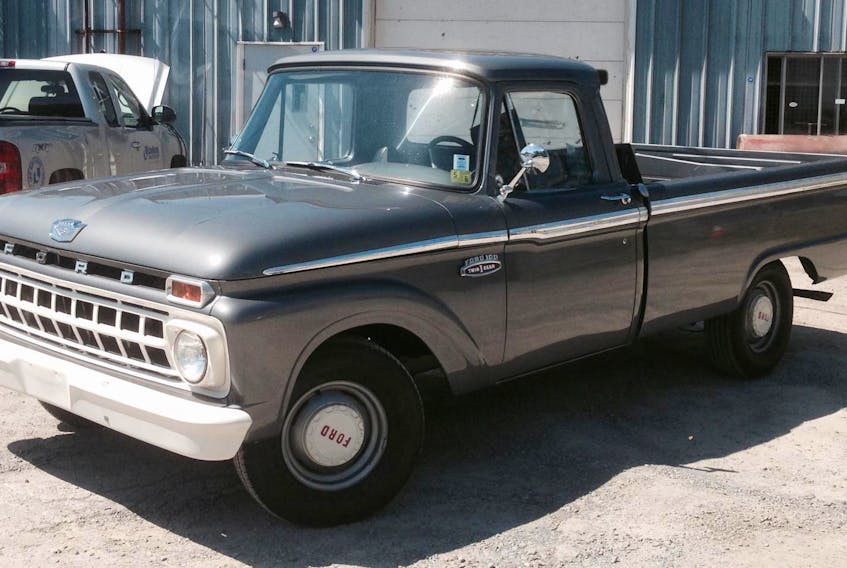Strapping into a vehicle that hasn’t been driven for a long time and hitting the road can be a tense affair. I’ve been there.
Earlier this year it was our 1991 Jimmy on a road trip from Moncton to Halifax. It usually takes about that much distance to build up the faith so by the time the trek was over, my trust in the 28-year-old rig was solidified.
Last week when I picked up my 25-year restoration project after getting a brake job, I slipped into another game of wait and see. I had to pick up my mother at the Bulk Barn in Dartmouth and she was keen on getting a drive in our 1965 Ford F-100 pickup truck.
Over the past quarter century, a number of parties have had their hands in rebuilding the farm truck I bought from a dog breeder in Bandera, Texas.
As I pulled out of Bemister Auto Sales and Repair in Dartmouth with spanking new brakes, safety inspection and registration I joked to Derek Bemister about hoping he didn’t see the gunmetal grey relic returning in a half hour on the back of a flat deck tow truck.
The old Ford had been in storage for six years. This was its first real road test.
It was only the second time I had driven it since having a four-barrel carburetor and headers installed about six years ago, so I rumbled around Dartmouth back streets to gain confidence. Then I pulled onto Highway 111 to get Mum and the ingredients for her guaranteed-to-make-you-go health muffins.
All good, not an engine sputter or skip on the 53-year-old pick-up truck so I slowly accelerated to 90 km/h. No fuel or oil smells. No smoking wires or vibrations. No problem.
Three kilometres later, without warning, the engine quit. Just like that. I was going down as I whizzed past Mic Mac Mall in the middle lane.
My first thought was about those pesky flight instructors at flying school in Moose Jaw, Saskatchewan where I was training on Tudor jets in the early 1970s. As soon as you were feeling comfortable about your take-off and climb-out, the instructor would pull the throttle and yell “Flame Out,” sending you into a mental spiral you had to sweat your way out of.
I pulled out the choke and left the clutch out in high gear hoping for a restart, but no luck. Indeed, the old F-100 was going down and it was time to start thinking, fast.
I was in the centre lane of one of Halifax’s busiest highways during Friday rush hour and my immediate concern was to get safely off the road with minimal traffic disturbance.
I assessed the situation. The truck doesn’t have power brakes or power steering so steering or stopping was not affected when the engine died. With battery power, I still had turn signals and brake lights. Checking the right mirror, I saw an opening and coasted across two lanes and lined up for the Waverly Road exit. It is a slight downhill, so the speed was holding until I nipped onto an area on the side of the ramp and managed to pull completely off the road.
It was all over in a matter of 20 seconds. I went from top-of-the-world cruising in a relic pick-up truck to side-of-the-road losing after a series of quick decisions because its engine quit without the slightest warning.
I tried to start it. Not even a whimper of life. I pulled the choke again, still no go so I called a tow truck and waited.
I wondered how the abort manoeuvre would have worked out in a modern vehicle. An engine stall would mean a change in steering effort. Although the power brakes would still have functioned, they would have required much more pressure on the pedal.
While waiting and giving the thumbs up to two curious police officers in a paddy wagon, I realized that, considering all the kilometres I’ve driven over the years, there have been very few engine failures on the road.
Our diesel GMC Suburban started quitting off and on in the 1985 Alcan 5000 road rally, but I replaced the fuel filter and got back in the game. A blown belt on a rear engine 1966 Chevy Corvair ended an early morning run from Moncton to Fredericton and a blown coolant line on a Hyundai in a northern New Brunswick arctic chill froze that road trip in its tracks, and that’s about it.
For good reason, our trust in technology has been growing, especially in the past 20 years because these days cars and trucks are reliable, all of them. Considering how many vehicles are out there, think of how few broken down ones are encountered on the side of the road.
When the tow truck arrived, I had opened the hood, removed the air cleaner and had my nose in the carburetor.
“I can’t smell fuel,” I told the driver. “Probably a plugged fuel filter.”
Or perhaps the old Ford had just run out of fuel.









